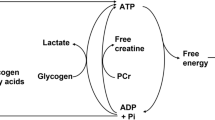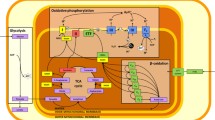Abstract
Our understanding of what happens in working muscle and at the whole-body level at sea level and at high altitude is different from that a few years ago. If dietary CHO and nutrition are adequate, at sea level metabolism shifts from a mix of lipid and CHO-derived fuels toward carbohydrate (glycogen, glucose, and lactate) oxidation at moderate and greater exercise intensities. As given by the Crossover Concept, a percentage to total energy expenditure, lipid oxidation is greatest at exercise power outputs eliciting 45–50 % of VO2max with greater intensities requiring relatively more CHO and lesser lipid oxidation. At altitude, a given exercise power output is achieved at a greater relative intensity expressed as % VO2max. Hence, exercise under conditions of hypoxia requires greater glycolytic flux, and lactate production than does the same effort at sea level, normoxic conditions. Glycolytic flux is further augmented at altitude by the effect of hypoxemia on sympathetic nervous system activity. Hence, augmented lactate production during exercise is adaptive. Over the short term, accelerated lactate flux provides ATP supporting muscle contraction and balances cytosolic redox. As well, lactate provides and energy substrate and gluconeogenic precursor. Over a longer term, via redox and ROS-generating mechanisms, lactate may affect adaptations in mitochondrial biogenesis and solute (glucose and lactate) transport. While important, the energy substrate, gluconeogenic, and signaling qualities of lactate production and disposal at altitude need to be considered within the context of overall dietary energy intake and expenditure during exercise at sea level and high altitude.
Access this chapter
Tax calculation will be finalised at checkout
Purchases are for personal use only
Similar content being viewed by others
References
Brooks GA, Gladden LB. Metabolic systems: non-oxidative (Glycolytic and Phosphagen). In: Tipton CM, editor. Exercise physiology: people and ideas. Bethesda, MD: American Physiological Society; 2003. p. 322–60.
Brooks GA, Donovan CM. Effect of training on glucose kinetics during exercise. Am J Physiol. 1983;244:E505–12.
Donovan CM, Brooks GA. Endurance training affects lactate clearance, not lactate production. Am J Physiol. 1983;244:E83–92.
Brooks GA. Mammalian fuel utilization during sustained exercise. Comp Biochem Physiol B. 1998;120:89–107.
Schurr A. Lactate: the ultimate cerebral oxidative energy substrate? J Cereb Blood Flow Metab. 2006;26:142–52.
Larsen TS, Rasmussen P, Overgaard M, Secher NH, Nielsen HB. Non-selective beta-adrenergic blockade prevents reduction of the cerebral metabolic ratio during exhaustive exercise in humans. J Physiol. 2008;586:2807–15.
Miller BF, Fattor JA, Jacobs KA, Horning MA, Suh S-H, Navazio F, Brooks GA. Lactate-glucose interaction in men during rest and exercising using lactate clamp procedure. J Physiol. 2002;544:963–75.
Sonveaux P, Végran F, Schroeder T, Wergin MC, Verrax J, Rabbani ZN, De Saedeleer CJ, Kennedy KM, Diepart C, Jordan BF, Kelley MJ, Gallez B, Wahl ML, Feron O, Dewhirst MW. Targeting lactate-fueled respiration selectively kills hypoxic tumor cells in mice. J Clin Invest. 2008;118:3930–42.
Reeves JT, Wolfel EE, Green HJ, Mazzeo RS, Young AJ, Sutton JR, Brooks GA. Oxygen transport during exercise at high altitude and the lactate paradox: lessons from Operation Everest II and Pikes Peak. In: Exercise and sport science reviews, vol. 20. Baltimore, MD: Williams and Wikins; 1992. p. 275–96.
Dill DB, Edwards HT, Fölling A, Oberg SA, Pappenheimer AM, Talbott JH. Adaptations of the organism to changes in oxygen pressure. J Physiol. 1931;71:47–63.
Edwards HT. Lactic acid in rest and work at high altitudes. Am J Physiol. 1936;116:367–75.
Brooks GA, Butterfield GE, Wolfe RR, Groves BM, Mazzeo RS, Sutton JR, Wolfel EE, Reeves JT. Decreased reliance on lactate during exercise after acclimatization to 4,300m. J Appl Physiol. 1991;71:333–41.
Sutton JR, Reeves JT, Wagner PD, Groves BM, Cymerman A, Malconian MK, Rock PB, Young PM, Walter SD, Houston CS. Operation Everest II: oxygen transport during exercise at extreme simulated altitude. J Appl Physiol. 1988;64:1309–21.
Lundby C, Van Hall G. Substrate utilization in sea level residents during exercise in acute hypoxia and after 4 weeks of acclimatization to 4100 m. Acta Physiol Scand. 2002;176:195–201.
Butterfield GE, Gates J, Brooks GA, Groves BM, Mazzeo RS, Sutton JR, Reeves JT. Energy balance and weight loss during three weeks at 4,300m. J Appl Physiol. 1992;72:1741–8.
Mazzeo RS, Brooks GA, Butterfield GE, Cymerman A, Roberts AC, Selland M, Wolfel EE, Reeves JT. β-adrenergic blockade does not prevent lactate response to exercise after acclimatization to high altitude. J Appl Physiol. 1994;76:610–5.
Brooks GA, Butterfield GE, Wolfe RR, Groves BM, Mazzeo RS, Sutton JR, Wolfel EE, Reeves JT. Increased dependence on blood glucose after acclimatization to 4,300m. J Appl Physiol. 1991;70:919–27.
Roberts AC, Reeves JT, Butterfield GE, Mazzeo RS, Sutton JR, Wolfel EE, Brooks GA. Altitude and ß-Blockade augment glucose utilization during exercise. J Appl Physiol. 1996;80:605–15.
Cartee GD, Douen AG, Ramlal T, Klip A, Holloszy JO. Stimulation of glucose transport in skeletal muscle by hypoxia. J Appl Physiol. 1999;70:1593–600.
Zinker BA, Wilson RD, Wasserman DH. Interaction of decreased arterial PO2 and exercise on carbohydrate metabolism in the dog. Am J Physiol. 1995;269:E409–17.
Brooks GA, Mercier J. The balance of carbohydrate and lipid utilization during exercise: the ‘crossover’ concept. Brief review. J Appl Physiol. 1994;76:2253–61.
Braun B, Mawson JT, Muza SR, Dominick S, Brooks GA, Horning MA, Rock PB, Moore LG, Mazzeo RS, Ezeji-Okoye SC, Butterfield GE. Women at altitude: carbohydrate utilization during rest and exercise at 4300 m elevation and across the menstrual cycle. J Appl Physiol. 2000;88:246–56.
Roberts AC, Butterfield GE, Reeves JT, Wolfel EE, Brooks GA. Acclimatization to 4,300 m altitude decreases reliance on fat as substrate. J Appl Physiol. 1996;81:1762–71.
Friedlander AL, Jacobs KA, Fattor JA, Horning MA, Hagobian TA, Bauer TA, Wolfel EE, Brooks GA. Contributions of working muscle to whole body lipid metabolism vary with exercise intensity and training. Am J Physiol Endocrinol Metab. 2007;292:E107–16.
Wallis GA, Friedlander AL, Jacobs KA, Horning MA, Fattor JA, Wolfel EE, Lopaschuk GD, Brooks GA. Substantial working muscle glycerol turnover during two-legged cycle ergometry. Am J Physiol Endocrinol Metab. 2007;293:E950–7.
Hughes EF, Turner SC, Brooks GA. Effects of glycogen depletion and pedaling speed on the “anaerobic threshold”. J Appl Physiol. 1982;52:1598–607.
Heigenhauser GJ, Sutton JR, Jones NL. Effect of glycogen depletion on the ventilatory response to exercise. J Appl Physiol. 1983;54:470–4.
Braun B. Effects of high altitude on substrate use and metabolic economy: cause and effect? Med Sci Sports Exerc. 2008;40:1495–500.
Henderson GC, Fattor JA, Horning MA, Faghihnia N, Johnson ML, Mau TL, Luke-Zeitoun M, Brooks GA. Lipolysis and free fatty acid metabolism during the post-exercise recovery period. J Physiol. 2007;584:963–81.
Henderson GC, Fattor JA, Horning MA, Faghihnia N, Johnson ML, Luke-Zeitoun M, Brooks GA. More precise postexercise glucoregulation in women than men. Am J Clin Nutr. 2008;87:1686–94.
Larsen JJ, Hansen JM, Olsen NV, Galbo H, Dela F. The effect of altitude hypoxia on glucose homeostasis in men. J Physiol. 1997;504:241–9.
Wadley GD, Lee-Young RS, Canny BJ, Wasuntarawat C, Chen ZP, Hargreaves M, Kemp BE, McConell GK. Effect of exercise intensity and hypoxia on skeletal muscle AMPK signaling and substrate metabolism in humans. Am J Physiol Endocrinol Metab. 2006;290:E694–702.
Bergman BC, Wolfel EE, Butterfield GE, Lopaschuk G, Casazza GA, Horning MA, Brooks GA. Active muscle and whole body lactate kinetics after endurance training in men. J Appl Physiol. 1999;87:1684–96.
Stanley WC, Gertz EW, Wisneski JA, Morris DL, Neese R, Brooks GA. Systemic lactate turnover during graded exercise in man. Am J Physiol. 1985;249:E595–602.
Mazzeo RS, Brooks GA, Schoeller DA, Budinger TF. Disposal of [1-13C]-lactate during rest and exercise. J Appl Physiol. 1986;60:232–41.
Brooks GA, Wolfel EE, Groves BM, Bender PR, Butterfield GE, Cymerman A, Mazzeo RS, Sutton JR, Wolfe RR, Reeves JT. Muscle accounts for glucose disposal but not lactate release during exercise after acclimatization to 4,300 m. J Appl Physiol. 1992;72:2435–45.
Brooks GA, Wolfel EE, Butterfield GE, Cymerman A, Roberts AC, Mazzeo RS, Reeves JT. Poor relationship between arterial [lactate] and leg net release during steady-rate exercise at 4,300 m altitude. Am J Physiol. 1998;275:R1192–201.
Wolfel EE, Bender PR, Brooks GA, Butterfield GE, Groves BM, Mazzeo RS, Sutton JR, Reeves JT. Oxygen transport during steady state, submaximal exercise in chronic hypoxia. J Appl Physiol. 1991;70:1129–36.
Richardson RS, Noyszewski EA, Leigh JS, Wagner PD. Lactate efflux from exercising human skeletal muscle: role of intracellular PO2. J Appl Physiol. 1998;85:627–34.
Gertz EW, Wisneski JA, Stanley WC, Neese RA. Myocardial substrate utilization during exercise in humans. Dual carbon-labeled carbohydrate isotope experiments. J Clin Invest. 1988;82:2017–25.
Brooks GA, Dubouchaud H, Brown M, Sicurello JP, Butz CE. Role of mitochondrial lactate dehydrogenase and lactate oxidation in the ‘intra-cellular lactate shuttle’. Proc Natl Acad Sci U S A. 1999;96:1129–34.
Hashimoto T, Masuda S, Taguchi S, Brooks GA. Immunohistochemical analysis of MCT1, MCT2 and MCT4 expression in rat plantaris muscle. J Physiol. 2005;567:121–9.
Hashimoto T, Hussien R, Brooks GA. Colocalization of MCT1, CD147 and LDH in mitochondrial inner membrane of L6 cells: evidence of a mitochondrial lactate oxidation complex. Am J Physiol Endocrinol Metab. 2006;290:1237–44.
Hashimoto T, Hussien R, Cho H-S, Kaufer D, Brooks GA. Evidence for a mitochondrial lactate oxidation complex in rat neurons: a crucial component for a brain lactate shuttle. PLoS One. 2008;3(8):e2915.
Pagliarini DJ, Calvo SE, Chang B, Sheth SA, Vafai SB, Ong SE, Walford GA, Sugiana C, Boneh A, Chen WK, Hill DE, Vidal M, Evans JG, Thorburn DR, Carr SA, Mootha VK. A mitochondrial protein compendium elucidates complex I disease biology. Cell. 2008;134:112–23.
Yoon Y. Sharpening the scissors: mitochondrial fission with aid. Cell Biochem Biophys. 2004;41:193–206.
James DI, Parone PA, Mattenberger Y, Martinou JC. hFis1, a novel component of the mammalian mitochondrial fission machinery. J Biol Chem. 2003;278:36373–9.
Waterham HR, Koster J, Roermund CW, Mooyer PA, Wanders RJ, Leonard JV. A lethal defect of mitochondrial and peroxisomal fission. N Engl J Med. 2007;356:1736–41.
Cribbs JT, Strack S. Reversible phosphorylation of Drp1 by cyclic AMP-dependent protein kinase and calcineurin regulates mitochondrial fission and cell death. EMBO Rep. 2007;8:939–69.
Author information
Authors and Affiliations
Corresponding author
Editor information
Editors and Affiliations
Rights and permissions
Copyright information
© 2016 Springer Science+Business Media New York
About this chapter
Cite this chapter
Brooks, G.A. (2016). Energy Flux, Lactate Shuttling, Mitochondrial Dynamics, and Hypoxia. In: Roach, R., Hackett, P., Wagner, P. (eds) Hypoxia. Advances in Experimental Medicine and Biology, vol 903. Springer, Boston, MA. https://doi.org/10.1007/978-1-4899-7678-9_29
Download citation
DOI: https://doi.org/10.1007/978-1-4899-7678-9_29
Published:
Publisher Name: Springer, Boston, MA
Print ISBN: 978-1-4899-7676-5
Online ISBN: 978-1-4899-7678-9
eBook Packages: Biomedical and Life SciencesBiomedical and Life Sciences (R0)




